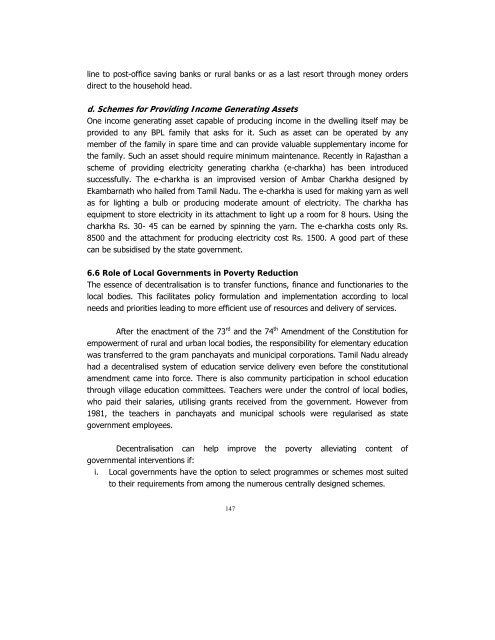POVERTY REDUCTION STRATEGY TN
Create successful ePaper yourself
Turn your PDF publications into a flip-book with our unique Google optimized e-Paper software.
line to post-office saving banks or rural banks or as a last resort through money orders<br />
direct to the household head.<br />
d. Schemes for Providing Income Generating Assets<br />
One income generating asset capable of producing income in the dwelling itself may be<br />
provided to any BPL family that asks for it. Such as asset can be operated by any<br />
member of the family in spare time and can provide valuable supplementary income for<br />
the family. Such an asset should require minimum maintenance. Recently in Rajasthan a<br />
scheme of providing electricity generating charkha (e-charkha) has been introduced<br />
successfully. The e-charkha is an improvised version of Ambar Charkha designed by<br />
Ekambarnath who hailed from Tamil Nadu. The e-charkha is used for making yarn as well<br />
as for lighting a bulb or producing moderate amount of electricity. The charkha has<br />
equipment to store electricity in its attachment to light up a room for 8 hours. Using the<br />
charkha Rs. 30- 45 can be earned by spinning the yarn. The e-charkha costs only Rs.<br />
8500 and the attachment for producing electricity cost Rs. 1500. A good part of these<br />
can be subsidised by the state government.<br />
6.6 Role of Local Governments in Poverty Reduction<br />
The essence of decentralisation is to transfer functions, finance and functionaries to the<br />
local bodies. This facilitates policy formulation and implementation according to local<br />
needs and priorities leading to more efficient use of resources and delivery of services.<br />
After the enactment of the 73 rd and the 74 th Amendment of the Constitution for<br />
empowerment of rural and urban local bodies, the responsibility for elementary education<br />
was transferred to the gram panchayats and municipal corporations. Tamil Nadu already<br />
had a decentralised system of education service delivery even before the constitutional<br />
amendment came into force. There is also community participation in school education<br />
through village education committees. Teachers were under the control of local bodies,<br />
who paid their salaries, utilising grants received from the government. However from<br />
1981, the teachers in panchayats and municipal schools were regularised as state<br />
government employees.<br />
Decentralisation can help improve the poverty alleviating content of<br />
governmental interventions if:<br />
i. Local governments have the option to select programmes or schemes most suited<br />
to their requirements from among the numerous centrally designed schemes.<br />
147

















